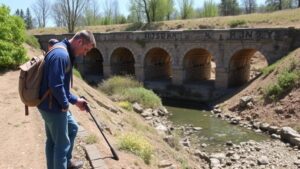Recognizing the Use of Camouflaged Natural Barriers in Treasure Sites
Recognizing the Use of Camouflaged Natural Barriers in Treasure Sites
Treasure hunting often conjures images of gleaming gold and hidden relics, yet the strategies employed to conceal these treasures are equally captivating. One of the most intriguing techniques used throughout history involves the utilization of camouflaged natural barriers. Understanding these barriers can be crucial for treasure hunters who are trying to locate hidden valuables in diverse environments.
The Concept of Camouflaged Natural Barriers
Camouflaged natural barriers are environmental features that obscure or protect treasures from discovery. e can be topographical elements such as hills, forests, or rivers that naturally deter both humans and wildlife from approaching an area. The strategic application of these features not only protects the treasure but also helps misdirect potential treasure hunters.
For example, the use of dense foliage can serve as a natural wall, preventing visual access to hidden sites. In contrast, steep cliff faces may serve as natural safeguards against intruders. Throughout history, civilizations have taken advantage of these natural defenses to encapsulate their riches securely, leading to the effective camouflaging of locations rich in hidden treasures.
Case Studies of Historical Applications
Several renowned historical examples highlight the strategic use of camouflaged natural barriers. The Inca civilization in South America expertly integrated their treasures within the Andes Mountains. The mountains not only offered a formidable backdrop but also acted as a robust barrier. Treasure sites like the lost city of Paititi have reportedly remained undiscovered for centuries due to their mountainous concealment.
- The Inca Empire utilized rugged terrain to protect vast reserves of gold and silver, with physical barriers formed by mountains, rivers, and forests complicating access.
- In another example, the rumored treasure of Captain Kidd was said to be buried in the dense vegetation of the Caribbean islands, where natural barriers concealed it from prying eyes.
Identifying Camouflaged Natural Barriers
Treasure hunters must develop specific skills to recognize camouflaged natural barriers effectively. Geographical awareness and analytical skills become essential. Here are some methods to identify these barriers:
- Aerial and Satellite Imagery: Utilizing modern technology like aerial photography and satellite views can reveal hidden topographical features, such as hills or dips, indicative of potential treasure sites.
- Terrain Analysis: Conducting a detailed analysis of a region’s geography, paying close attention to changes in elevation and vegetation, can help pinpoint natural barriers that may obscure treasure sites.
- Historical Maps: Old maps can provide vital clues about the original topography and vegetation cover. Overlaying historical maps with current geographical data might reveal obscured sites that have changed little over time.
Challenges in Navigating Natural Barriers
While natural barriers serve as protection for treasures, they can also pose significant challenges for treasure hunters. The dense growth of vegetation can make navigation difficult, significantly increasing the time and effort needed to explore a site. Also, natural obstacles can hinder technology-based detection methods, such as ground-penetrating radar or metal detectors.
Success necessitates a multifaceted approach where treasure hunters must balance the limitations posed by these barriers with the strategic understanding of their protective purposes. In some cases, developing physical fortitude and employing local guides familiar with the territory has proven beneficial in overcoming these challenges.
Real-World Applications
Treasure hunting is not solely a sport for enthusiasts; it has significant implications in archaeology and history. Recognizing camouflaged natural barriers aids archaeologists in revisiting historical narratives, uncovering artifacts that provide insights into ancient civilizations. The approach is valuable in preservation efforts, allowing for informed decisions on excavation while minimizing damage to the surrounding environment.
Actionable Takeaways
- Become proficient in identifying regional natural features that could serve as barriers; this can significantly enhance the likelihood of treasure discovery.
- Leverage modern technology such as aerial imagery while combining it with traditional knowledge for a comprehensive exploration strategy.
- Participate in workshops, field studies, and training sessions focused on terrain navigation and analysis to enhance your skills as a treasure hunter.
Ultimately, the recognition and understanding of camouflaged natural barriers can transform the practices of treasure hunting and archaeological studies alike, making it a vital aspect of the field. Respecting these natural features not only aids in the search but also contributes to the preservation of the rich cultural heritage they protect.



